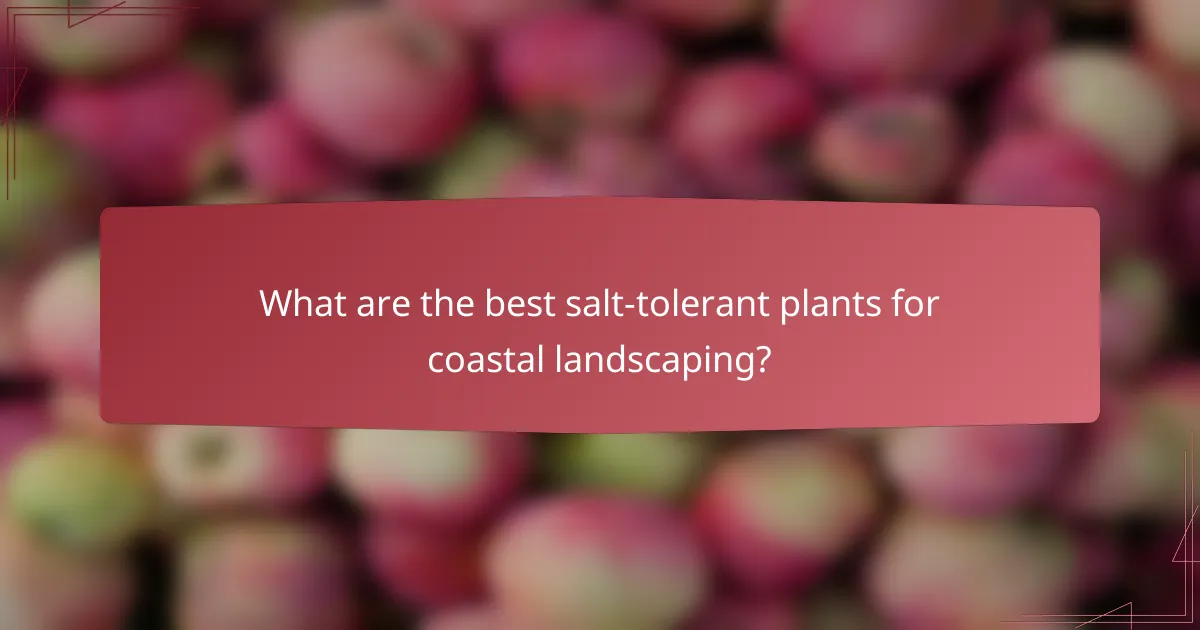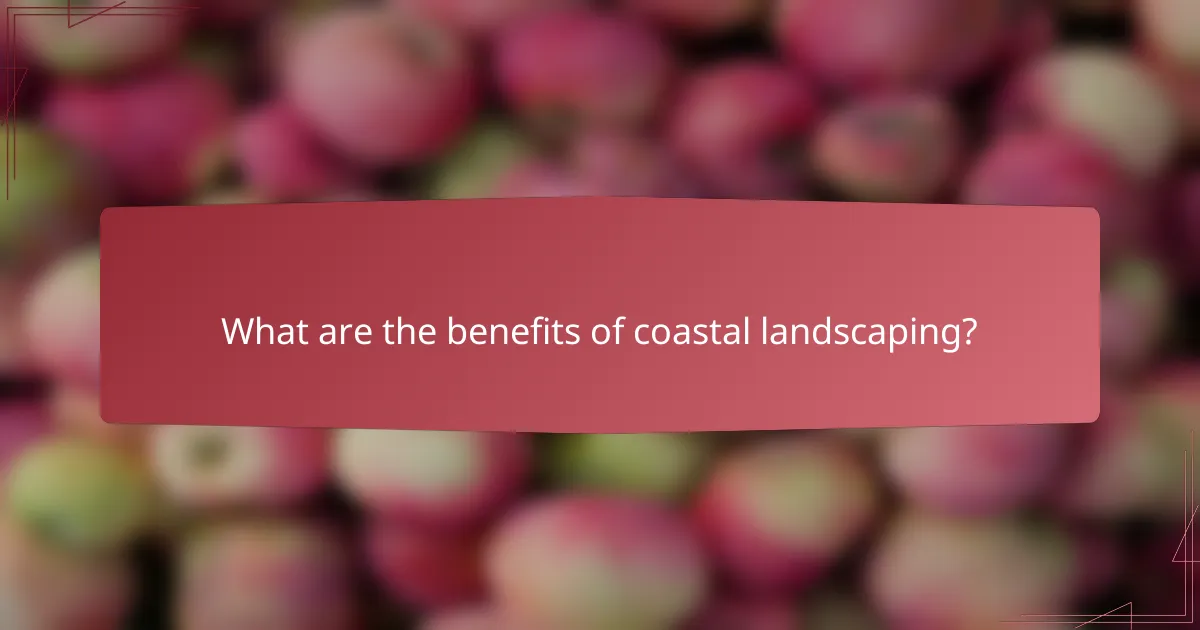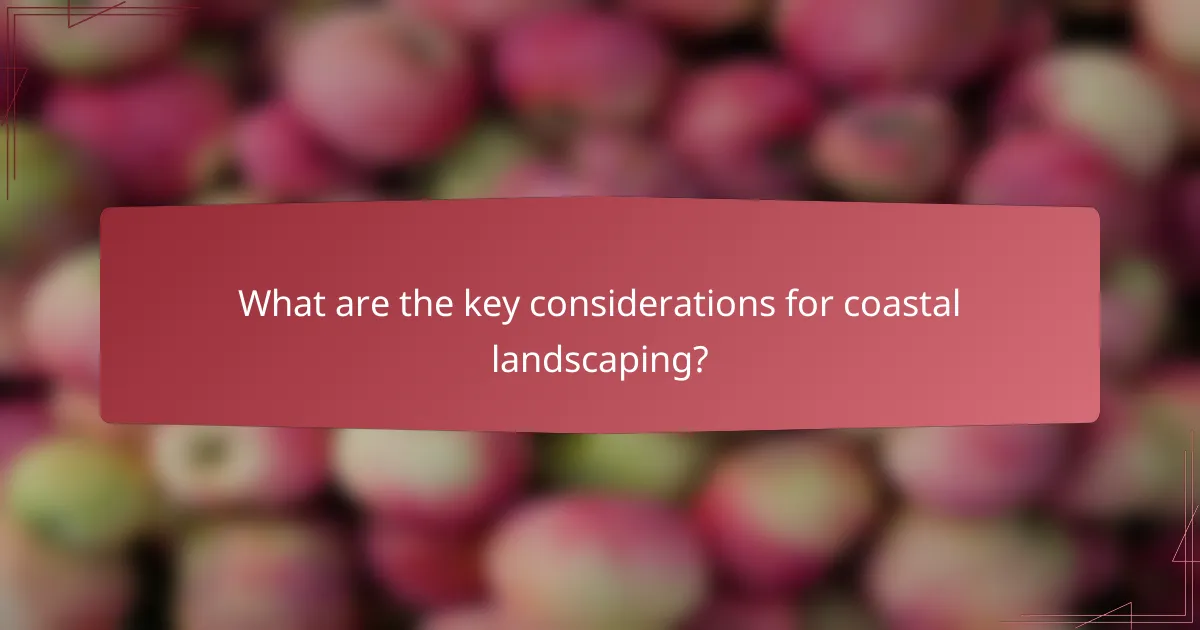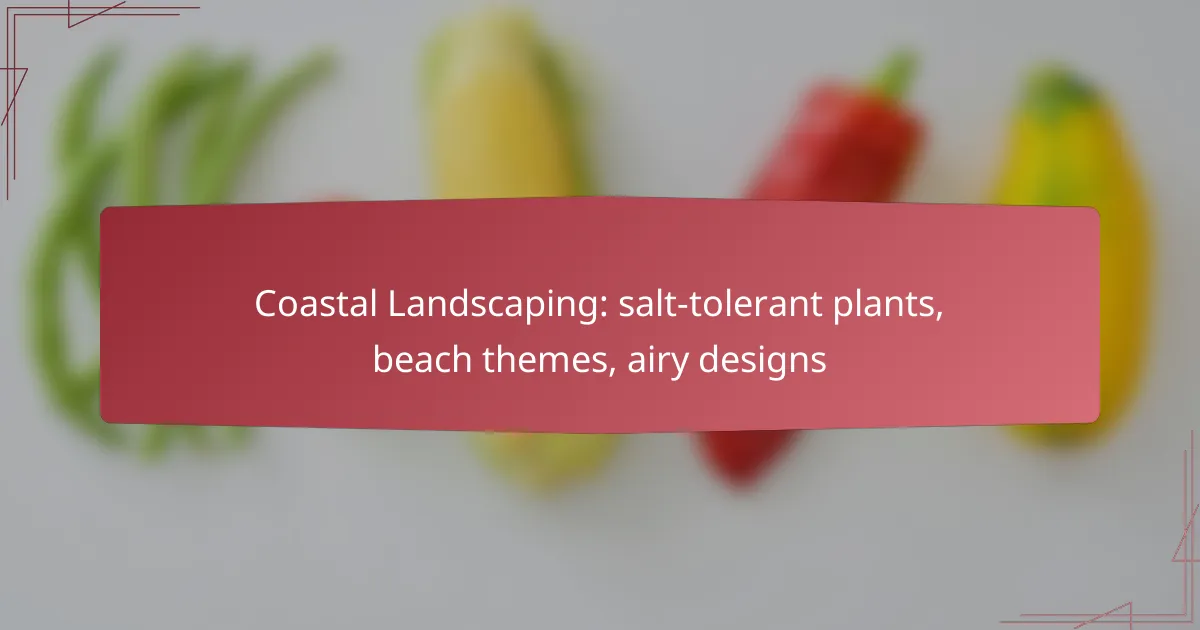Coastal landscaping offers a unique opportunity to create beautiful, sustainable gardens that thrive in challenging seaside conditions. By selecting salt-tolerant plants and incorporating airy design principles, you can evoke the essence of the beach while ensuring resilience against harsh elements. Emphasizing natural decorations and open spaces enhances both the aesthetic appeal and the functionality of your coastal retreat.

What are the best salt-tolerant plants for coastal landscaping?
Salt-tolerant plants are essential for coastal landscaping as they can thrive in sandy, saline soils and withstand harsh winds. Choosing the right species can enhance the beauty of beachside gardens while ensuring sustainability and low maintenance.
Beach Strawberry (Fragaria chiloensis)
Beach Strawberry is a resilient ground cover that flourishes in coastal environments. Its ability to tolerate salt and sandy soils makes it an excellent choice for beach landscapes.
This plant produces small, sweet berries and vibrant green leaves, adding both aesthetic and edible value to your garden. It spreads quickly, helping to prevent erosion while providing habitat for local wildlife.
Seaside Goldenrod (Solidago sempervirens)
Seaside Goldenrod is a perennial plant known for its bright yellow flowers that bloom in late summer and fall. It thrives in coastal areas, tolerating salt spray and poor soil conditions.
This plant is not only visually appealing but also attracts pollinators like bees and butterflies, enhancing biodiversity in coastal gardens. It can grow up to three feet tall, making it suitable for adding vertical interest to your landscape.
Saltbush (Atriplex spp.)
Saltbush is a hardy shrub that excels in saline environments, making it ideal for coastal landscaping. Its thick, succulent leaves are adapted to conserve water and withstand salt exposure.
These plants can vary in size, with some species reaching up to six feet tall. Saltbush is often used for windbreaks and to stabilize sandy soils, making it a practical choice for coastal areas.
Beach Grass (Ammophila breviligulata)
Beach Grass is a crucial plant for stabilizing dunes and preventing erosion along coastlines. Its deep root system helps anchor sand, making it vital for maintaining beach integrity.
This grass can grow in clumps and reaches heights of about two to three feet. It thrives in full sun and is highly tolerant of salt, making it a staple in coastal restoration projects.
Sea Oats (Uniola paniculata)
Sea Oats are a key species for coastal dune ecosystems, known for their tall, graceful seed heads that sway in the breeze. They are highly effective at stabilizing sand dunes and preventing erosion.
This perennial grass can grow up to five feet tall and is well-adapted to sandy, salty soils. Sea Oats are also protected in many areas, so it’s important to check local regulations before planting.

How to create a beach-themed landscape?
To create a beach-themed landscape, focus on incorporating elements that evoke the coastal environment, such as sandy soil, natural decorations, and salt-tolerant plants. This approach not only enhances aesthetic appeal but also ensures resilience against coastal conditions.
Incorporate sandy soil and rock features
Using sandy soil is essential for a beach-themed landscape, as it mimics the natural coastal environment. This type of soil drains well and supports the growth of salt-tolerant plants. Consider adding rock features like boulders or pebbles to create visual interest and replicate coastal formations.
When selecting rocks, opt for local varieties that blend seamlessly with the surrounding landscape. Arrange them in natural clusters to enhance the organic feel of your design. Additionally, ensure that the sandy soil is mixed with organic matter to support plant health.
Use driftwood and seashell decorations
Driftwood and seashells are perfect for adding authentic coastal charm to your landscape. Use driftwood as natural sculptures or garden borders, which can create focal points and enhance the beach theme. Seashells can be scattered along pathways or used in decorative pots to reinforce the coastal vibe.
When incorporating these elements, choose pieces that are weathered and naturally shaped. Avoid using synthetic decorations, as they can detract from the natural aesthetic. A well-placed driftwood piece can serve as a conversation starter while blending beautifully with the surrounding plants.
Plant native coastal grasses and shrubs
Choosing native coastal grasses and shrubs is crucial for a beach-themed landscape, as these plants are adapted to thrive in sandy, salty environments. Species such as beach grass, sea oats, and saltbush not only enhance the aesthetic but also provide stability to the soil.
When selecting plants, consider their mature size and spacing to ensure a balanced look. Grouping plants in clusters can create a more natural appearance and mimic the way they grow in the wild. Regularly check for pests and diseases, as native plants can still be susceptible to local threats.

What are airy design principles for coastal gardens?
Airy design principles for coastal gardens focus on creating open, breezy spaces that enhance the natural beauty of the shoreline. These principles emphasize minimal barriers, light materials, and varied plant heights to foster a relaxed and inviting atmosphere.
Open spaces with minimal barriers
Creating open spaces with minimal barriers allows for unobstructed views and promotes airflow, which is essential in coastal environments. Consider using low fences or natural elements like driftwood to define areas without closing them off.
Incorporate wide pathways and seating areas that encourage movement and social interaction. Avoid tall structures that can block views or create a sense of confinement, opting instead for designs that blend seamlessly with the landscape.
Light-colored materials for pathways
Using light-colored materials for pathways enhances the airy feel of coastal gardens by reflecting sunlight and creating a sense of openness. Choose materials like pale stone, sandy-colored pavers, or light wood to complement the beach theme.
These materials not only look visually appealing but also help keep pathways cooler underfoot, which is beneficial in warmer coastal climates. Ensure that the pathways are wide enough for easy navigation and consider incorporating natural textures to maintain a relaxed vibe.
Layered plant heights for visual interest
Layering plant heights adds depth and visual interest to coastal gardens, making the space feel more dynamic. Use taller plants like ornamental grasses or shrubs at the back, with medium-height flowers in the middle, and low-growing ground covers in the front.
This arrangement not only creates a lush, inviting look but also allows for better airflow and sunlight penetration, which is crucial for plant health in coastal areas. Choose salt-tolerant species that thrive in sandy soils to ensure a vibrant and sustainable garden.

What are the benefits of coastal landscaping?
Coastal landscaping offers numerous advantages, including increased property value, enhanced local ecosystems, and protection against erosion and storm damage. By incorporating salt-tolerant plants and airy designs, homeowners can create sustainable and visually appealing outdoor spaces that thrive in coastal environments.
Enhances property value
Coastal landscaping can significantly enhance property value by creating an attractive and functional outdoor space. Homes with well-designed coastal gardens often appeal to buyers looking for properties in seaside areas, potentially leading to higher sale prices.
Investing in native, salt-tolerant plants and beach-themed designs can make a property stand out. Features like pathways, decks, and seating areas can further increase desirability, making the property more marketable.
Supports local wildlife
Coastal landscaping plays a crucial role in supporting local wildlife by providing habitats for various species. Native plants attract pollinators, such as bees and butterflies, while also offering food and shelter for birds and small mammals.
By choosing plants that are well-adapted to the coastal environment, homeowners can create a thriving ecosystem that benefits both the landscape and the local fauna. This not only enhances biodiversity but also contributes to the overall health of the coastal environment.
Reduces erosion and storm damage
Effective coastal landscaping can help reduce erosion and mitigate storm damage by stabilizing soil and protecting shorelines. Deep-rooted salt-tolerant plants can anchor the soil, preventing it from washing away during heavy rains or storms.
Incorporating features like dunes, native grasses, and strategically placed rocks can further enhance protection against wave action and flooding. Homeowners should consider local regulations and best practices for coastal landscaping to ensure their designs are effective and environmentally responsible.

What are the key considerations for coastal landscaping?
Coastal landscaping requires careful attention to factors such as soil salinity, drainage, and wind resistance. These elements are crucial for selecting appropriate plants and designing resilient outdoor spaces that can withstand coastal conditions.
Soil salinity and drainage
Soil salinity is a significant concern in coastal areas, as high salt levels can hinder plant growth. It’s essential to choose salt-tolerant plants that can thrive in these conditions, such as beach grass or sea oats.
Proper drainage is equally important, as waterlogged soil can lead to root rot. Incorporating raised beds or using sandy soil can improve drainage and create a healthier environment for your plants.
Wind resistance of plants
Coastal landscapes often experience strong winds, making wind resistance a key factor in plant selection. Opt for hardy species like junipers or native shrubs that can withstand gusts and maintain their structure.
When designing your landscape, consider planting in layers, with taller plants acting as windbreaks for shorter ones. This strategy can help protect more delicate plants from wind damage.
Permits for coastal modifications
Before making any modifications to coastal landscapes, it’s crucial to check local regulations and obtain necessary permits. Many coastal areas have specific guidelines to protect natural habitats and prevent erosion.
Consulting with local authorities or a landscaping professional can help ensure compliance with regulations, avoiding potential fines and ensuring sustainable practices in your coastal landscaping project.



